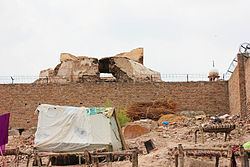Architectural styles Hindu temple Primary deity Prahlada | Governing body Pakistan Hindu Council | |
 | ||
Similar Multan Sun Temple, Shri Varun Dev Mandir, Lava temple - Lahore fort, Shiv Mandir - Umerkot, Shri Laxmi Narayan Mandir | ||
Prahladpuri Temple is an ancient Hindu temple located in Multan, Punjab, Pakistan. It is named after Prahlada and dedicated to the god Narasimha. The temple is at present in ruins, since its destruction in 1992 by a Muslim mob in retaliation for the destruction of Babri Masjid in Ayodhya, India by a Hindu mob earlier that year.
Contents
History
The original temple of Prahladpuri is said to have been built by Prahlada, son of Hiranyakashipu, the king of Multan (Kashya-papura) in honor of Narsing Avatar, an incarnation of Hindu god Vishnu, who emerged from the pillar to save Prahlada.
The Prahladapuri temple like the Sun Temple of Multan had been destroyed after Muslim conquest of Multan, suffered several material losses and was reduced to a nondescript shrine by the 19th century. It is located on top of a raised platform inside the Fort of Multan, adjacent to tomb of Hazrat Baha’ul Haq Zakariya. A mosque has subsequently built adjacent to temple. The records suggested by Dr. A.N. Khan say that temple was once rebuilt in decade of 1810, when area was under rule of Sikhs. However, Alexander Burnes, who visited the temple in 1831, said that he found it deserted and without a roof. Later, in year 1849, when British laid siege of Multan Fort against Mul Raj, a shell fired by British army fell on gunpowder store within the fort, thus destroying almost all of the fort except the mausoleums of Bahauddin Zakaria and his sons and the Prahladpuri temple complex. Alexander Cunningham described this temple as it was seen in 1853 by him who wrote that: “It was a square brick building with some very finely carved wooden pillars for the support of the roof. The present temple was first built in 1861 by Mahant Bawl Ram Das at cost of Rs.11,000 by way of public donation and again in 1872 by the subsequent Mahanta of Prahladpuri temple with donations from Thakur Dawara Fateh Chand Tanksalia and other Hindu citizens of Multan. But in 1881, while renovation of temple a major dispute arose between Hindus & Muslims over the height of shikhara of the temple and dome of the adjacent mausoleum, which led to riot in which 2 mosques and 22 temples were destroyed. The British government of Punjab did little to control the mobs and in this riot Prahladapuri temple was also sacked and obliterated. However, the temple was soon rebuilt by then prosperous Hindu community of Multan and was managed by the community, who regulated Mahant of Prahladpuri temple.
After the independence of Pakistan, most Hindus migrated to India and the affairs of temple were managed by minority Hindus of city. The original idols of Lord Narasimha was brought to India by Baba Narayan Das Batra from Multan at the time of independence in 1947. They are now placed in a temple at Haridwar.
In 1992, the temple was completely destroyed by an mob, in retaliation for the destruction of Babri Masjid in Ayodhya, India by a HIndu mob.
Features
The temple was built on a high platform inside Multan Fort and was before 1992 a prominent landmark of Multan. It had a main hall, circumlocutory and skylights and a large mandapa. The central hall had a replica of idol under a baldachin. Adjacent to temple was dharamshala complex.
Traditions, however, claim that the original temple was a columnar structure and both the roof and the columns supporting it were made of pure gold. It is further stated that for some unknown reason, this entire building sank into ground and over it was built a new temple.
Importance
The temple is of ancient origin and is located on the site where the original temple is said to have been built by Prahlada himself. It is the place where the Lord Narasimha is said to have appeared out of pillar to save him from his father Hiranyakashyapa. The Hindus, therefore, believe the tradition and the festival of Holika Dahan started here.
Present status
The temple is in ruins since its destruction by violent Muslim mob in 1992. In 2006, on occasion of Urs of Baha-ud-din Zakariya, the minister of government, ordered construction of facilities for Wuzu and in 2008 facilities for Langar in premises of temple. These actions were later protested by some NGOs as according to the Constitution of Pakistan, no Muslim construction can be done within the places of worship of other religions. A case was filed and court ordered stay on construction. The matter is still pending in court. Many peaceful protests were held by minority organizations and many persons and organizations have requested Government of Pakistan to restore this ancient temple of importance.
